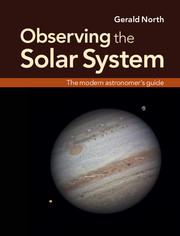Book contents
- Frontmatter
- Contents
- Preface
- Acknowledgements
- Chapter 1 Earth and sky
- Chapter 2 Moon and planet observer's hardware
- Chapter 3 The Solar System framed
- Chapter 4 Stacking up the Solar System
- Chapter 5 Our Moon
- Chapter 6 Mercury and Venus
- Chapter 7 Mars
- Chapter 8 Jupiter
- Chapter 9 Saturn, Uranus and Neptune
- Chapter 10 Small worlds
- Chapter 11 Comets
- Chapter 12 Our daytime star
- Appendix 1 Telescope collimation
- Appendix 2 Field-testing a telescope's optics
- Appendix 3 Polar alignment
- Index
- Frontmatter
- Contents
- Preface
- Acknowledgements
- Chapter 1 Earth and sky
- Chapter 2 Moon and planet observer's hardware
- Chapter 3 The Solar System framed
- Chapter 4 Stacking up the Solar System
- Chapter 5 Our Moon
- Chapter 6 Mercury and Venus
- Chapter 7 Mars
- Chapter 8 Jupiter
- Chapter 9 Saturn, Uranus and Neptune
- Chapter 10 Small worlds
- Chapter 11 Comets
- Chapter 12 Our daytime star
- Appendix 1 Telescope collimation
- Appendix 2 Field-testing a telescope's optics
- Appendix 3 Polar alignment
- Index
Summary
Comets come in vastly different sizes, very different brightnesses and, to some extent, different shapes. When we get to see them, most appear as filmy or misty smudges of greyish light against the sky with one end, the head, being the brightest and most compact part. The head of the comet is also the site of the comet's coma, which appears like a spheroidal ball of mist. Often the coma contains a bright star-like speck of light, the false nucleus. A tail often fans out from the head, or sometimes extends out as a narrow swath of filmy mist. Not all comets display tails, though.
Long ago, before we understood comets in scientific terms, their appearances generated widespread fear and foreboding. Even today we call their appearances in our skies apparitions.
GHOSTLY VISITORS
The images of comets displayed in this chapter are all very much just ‘snapshots’ in their lives. A comet’s form is not constant but changes and evolves, growing as it moves into our skies. Then it changes further, diminishing as it retreats back into the depths of space. Figure 11.1 shows an idealised diagramof a fully developed comet of larger than average size.
- Type
- Chapter
- Information
- Observing the Solar SystemThe Modern Astronomer's Guide, pp. 357 - 402Publisher: Cambridge University PressPrint publication year: 2012



